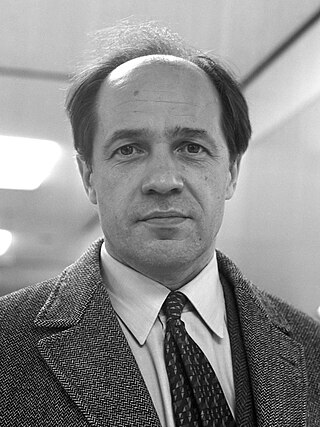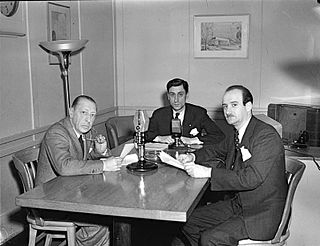Related Research Articles

Pierre Louis Joseph Boulez was a French composer, conductor and writer, and the founder of several musical institutions. He was one of the dominant figures of post-war contemporary classical music.

The xylorimba is a pitched percussion instrument similar to an extended-range xylophone with a range identical to some 5-octave celestas or 5-octave marimbas, though typically an octave higher than the latter. Despite its name, it is not a combination of a xylophone and a marimba; its name has been a source of confusion, as many composers have called for a 'xylorimba', including Alban Berg, Pierre Boulez and Olivier Messiaen, but for parts requiring only a four-octave xylophone. However, Pierre Boulez wrote for two five-octave xylorimbas in Pli selon pli.

IRCAM is a French institute dedicated to the research of music and sound, especially in the fields of avant garde and electro-acoustical art music. It is situated next to, and is organisationally linked with, the Centre Pompidou in Paris. The extension of the building was designed by Renzo Piano and Richard Rogers. Much of the institute is located underground, beneath the fountain to the east of the buildings.

Stuart Oliver Knussen was a British composer of contemporary classical music and conductor. Among the most influential British composers of his generation, his relatively few compositions are "rooted in 20th-century modernism, [but] beholden to no school but his own"
Polyphonie X (1950–51) is a three-movement composition by Pierre Boulez for eighteen instruments divided into seven groups, with a duration of roughly fifteen minutes. Following the work's premiere, Boulez withdrew the score, stating that it suffered from "theoretical exaggeration". Despite Boulez's dissatisfaction with the piece, it played a key role in his development: one writer called it "the linchpin connecting Boulez's early mastery of gesture and contour... with his later interest in large ensembles and grand forms", his "brave 'first attempt' to produce a work that exhausted a particular musical technique with large orchestral forces by developing an expansive, additive structure at the earliest stages of composition", and "one of the purest representations of Boulez's first turn toward integral serialism".

Rituel in memoriam Bruno Maderna (1974–75) is a composition for orchestra in eight groups by Pierre Boulez. Biographer Dominique Jameux wrote that the piece has "obvious audience appeal", and that it represented a desire to establish "immediate, almost physical contact with the public". Jameux also noted that Rituel represents one of the few examples of repetitive music written by Boulez. Author Jonathan Goldman wrote that, of Boulez's works, Rituel is the one that "most evokes... the sound worlds of non-Western musical ensembles, be they Indonesian, African or South American."
Elegy for J.F.K. is a piece of vocal music composed by the Russian-born composer Igor Stravinsky in 1964, commemorating the assassination of U.S. President John F. Kennedy.
Sir William Frederick Glock, CBE was a British music critic and musical administrator who was instrumental in introducing the Continental avant-garde, notably promoting the career of Pierre Boulez.

Igor Stravinsky wrote the Ebony Concerto in 1945 for the Woody Herman band known as the First Herd. It is one in a series of compositions commissioned by the bandleader and clarinetist featuring solo clarinet, and the score is dedicated to him. It was first performed on March 25, 1946 in Carnegie Hall in New York City, by Woody Herman's Band, conducted by Walter Hendl.
The Sonatina for Violin and Harpsichord is a three-movement, neoclassical chamber work composed by Walter Piston in 1945, that marks the beginning of his postwar style.

Abraham and Isaac is a sacred ballad for baritone and orchestra composed in 1962–63 by Igor Stravinsky.
"Epitaphium" is a short chamber-music composition by Igor Stravinsky, for flute, clarinet, and harp. The score was composed in 1959 and is inscribed in German, "Für das Grabmal des Prinzen Max Egon zu Fürstenberg". A performance last for less than two minutes.
The term Mixed music describes music combining acoustic instruments and fixed-media electronics and/or real-time electronic instrumental transformations; in other words, music which combines acoustic-instrumental and electronic sounds sources, not including electrically amplified instruments, such as the electric guitar and electronic instruments such as the theremin, electronic organs & keyboards, etc. Mixed music is therefore a subcategory of electronic music. While this term may be applied to many genres, the it generally refers to contemporary classical music and, is therefore distinct from live electronic music.
Danses concertantes is a work for chamber orchestra by Igor Stravinsky, composed in 1942. A performance lasts about twenty minutes. Although written as an abstract ballet for concert performance, it has been choreographed numerous times.
John Carewe is a British conductor and teacher.

Dérive 1 is a composition for six-part instrumental ensemble by French composer Pierre Boulez. It was composed in 1984.
Domaines is a composition by Pierre Boulez. Written during 1961–1968, it exists in two versions, one for clarinet solo, the other for clarinet solo and six instrumental groups. Like a number of other Boulez works of this period, it uses mobile form.
References
- ↑ Annie Labussière and Jean-Marc Chouvel, "Pierre Boulez: Mémoriale (...explosante-fixe... originel)", Musurgia: Analyse et pratique musicales 4, no. 1 (1997): 42–66. Citation on 44, quoting André Breton, "L'Amour fou", OEuvres complètes (Paris, Gallimard, coll. Pléiade, 1992), 2:687.
- 1 2 3 4 5 6 7 Javier Alejandro Garavaglia, "Raising Awareness about Complete Automation of Live-electronics: A Historical Perspective", in Auditory Display: 6th International Symposium, CMMR/ICAD 2009, Copenhagen, Denmark, May 18–22, 2009, edited by Sølvi Ystad, 443–45, Lecture Notes in Computer Science 5954; LNCS Sublibrary SL 3 (Berlin and New York: Springer, 2010).[ page needed ]
- ↑ Pierre Boulez, Elliott Carter, Aaron Copland, Alexander Goehr, Elisabeth Lutyens, Darius Milhaud, and Roger Sessions, [Supplement]: "In Memoriam: Igor Stravinsky. Canons & Epitaphs, Set 2". Tempo, new series, no. 98 (1972): [13–26 of 27 unnumbered pages (inserted between pages 22 and 23), citation on 13].
- ↑ Susan Bradshaw, "Comparing Notes", Musical Times 137, no. 1844 (October 1996): 5–12. Citation on 8.
- ↑ Annie Labussière and Jean-Marc Chouvel, "Pierre Boulez: Mémoriale (...explosante-fixe... originel)", Musurgia: Analyse et pratique musicales 4, no. 1 (1997): 42–66. Citation on 44.
- ↑ Edward Campbell, Boulez, Music and Philosophy, Music in the Twentieth Century 27 (Cambridge and New York: Cambridge University Press, 2010): p.206. ISBN 978-0-521-86242-4.
- ↑ Pierre Boulez, Elliott Carter, Aaron Copland, Alexander Goehr, Elisabeth Lutyens, Darius Milhaud, and Roger Sessions, [Supplement]: "In Memoriam: Igor Stravinsky. Canons & Epitaphs, Set 2". Tempo, new series, no. 98 (1972): [13–26 of 27 unnumbered pages, citation on 25–26].
- ↑ Pierre Boulez, Elliott Carter, Aaron Copland, Alexander Goehr, Elisabeth Lutyens, Darius Milhaud, and Roger Sessions, [Supplement]: "In Memoriam: Igor Stravinsky. Canons & Epitaphs, Set 2". Tempo, new series, no. 98 (1972): [27 unnumbered pages, editorial note on 27].
- ↑ New York (January 20, 1973). "New German Invention Alters Sound Direction", Billboard, p.46. Vol. 85, No. 3. ISSN 0006-2510.
- ↑ Annie Labussière and Jean-Marc Chouvel, "Pierre Boulez: Mémoriale (...explosante-fixe... originel)", Musurgia: Analyse et pratique musicales 4, no. 1 (1997): 42–66. Citation on 45.
- ↑ Paolo Dal Molin, "Introduction à la famille d'oeuvres ...explosante-fixe... de Pierre Boulez: Étude philologique", PhD diss. (Nice: Université de Nice—Sophia Antipolis, 2007): 17.
- ↑ Susan Bradshaw, "Boulez at 65", Musical Times 131, no. 1765 (March 1990): 127–28. Citation on 127.
- ↑ Susan Bradshaw, "Comparing Notes", Musical Times 137, no. 1844 (October 1996): 5–12. Citations on 8 and 11–12.
- 1 2 Thomas May. "...explosante-fixe..." Los Angeles Philharmonic. Archived from the original on 2012-06-14. Retrieved 27 August 2011.
- 1 2 "Pierre Boulez – ... explosante-fixe ..." Universal Edition . Retrieved 27 August 2011.